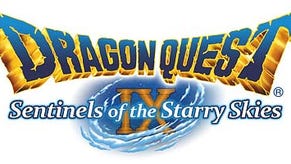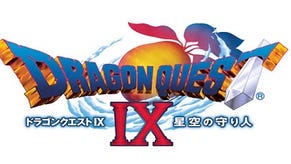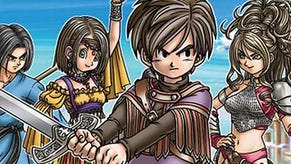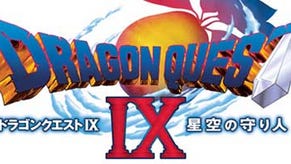Remember When... Dragon Quest 9 Shocked the World?
Robust multiplayer options and a brief affair with action-based gameplay made Dragon Quest 9 the Shockmaster of the Dragon Quest series.
This article first appeared on USgamer, a partner publication of VG247. Some content, such as this article, has been migrated to VG247 for posterity after USgamer's closure - but it has not been edited or further vetted by the VG247 team.
Courage and wit have served the Dragon Quest series well, for this month marks Dragon Quest 9's 10th anniversary in North America. If the Dragon Quest games are as steady and dependable as a veteran knight, Dragon Quest 9: Sentinels of the Starry Skies is the impulsive child who inherited their parent's potential, but has no desire to be slavish towards the "old ways."
Dragon Quest 9 is unique and different to a degree that was almost shocking at the time of its development. That was by design: Yuji Horii, the father of Dragon Quest, wanted very much for Westerners to finally pay close attention to the series, which had been venerated in Japan since 1986. But Dragon Quest 9's construction got so ambitious at times, the team had to walk the entire project back or risk losing its dedicated Japanese audience. Despite the shock and controversy, it managed to capture a respectable number of those coveted Western attention spans. That was thanks to some of the wilder ideas that flew against the notion of RPGs being lonely quests for single players.
Wyrms on the Go
One of Dragon Quest 9's biggest surprises was coupled with the game's announcement at a press conference in December 2006: It was in development for the Nintendo DS, not any of the consoles on the market at the time. "The DS version is not a side-story, but a true part of the series," Horii said.
It was a huge coup at the time. It was almost beyond imagining that the little Nintendo DS could deliver a satisfying mainline Dragon Quest game, a series known for huge maps and grand bestiaries. 2004's Dragon Quest 8 for the PlayStation 2 had a massive overworld and dozens of hours of content. How could a Nintendo DS game possibly compete?
In retrospect, it's not surprising Square Enix took Dragon Quest to the Nintendo DS. Nintendo's dual-screen handheld was a hit as soon as it shot out the gate in 2004, and by the time Square Enix made its announcement, the Nintendo DS Lite was enjoying titanic success. By contrast, consoles were in a shakier space. The PlayStation 3 was brand-new at the time of the press conference, and the Xbox 360 didn't have much of a presence in Japan. Japan was also making a clear shift to portable distractions like the DS, the PSP, and feature phones. Consoles were starting to lose some steam.
Besides, even when Square Enix was simply Enix, it was never shy about changing console loyalties whenever it was deemed necessary: Its longtime partnership with Nintendo ended abruptly when it became clear the PlayStation was more lucrative (and easier to develop for) than the Nintendo 64.
Square Enix could theoretically have developed Dragon Quest 9 for the PlayStation 2. Though the console was old news by 2006, its install base was enormous. Somewhere in a parallel universe, there is a Dragon Quest 9 for the PlayStation 2, and it easily sold millions. But here on Earth 33, Square Enix made its choice with the Nintendo DS. Then it continued to shift the boundaries that made—and still make—Dragon Quest games beloved amongst hardcore fans of turn-based JRPGs.
A Westward-Bound Flight of Dragons
For as long as Dragon Quest has existed, Square Enix has tried hard to get the series over with Western audiences. Most of the attempts whiffed, but Yuji Horii's desire to court the West flared up again when it was time to plan Dragon Quest 9.
The team decided potential Western fans might appreciate a more action-oriented experience. Indeed, a brief look at Dragon Quest 9 brings to mind comparisons with action RPGs like The Legend of Zelda or Secret of Mana: monsters strut around the map within full view of the player, a very unusual feature for a game that was defined by random encounters. Up until that point, Dragon Quest's monsters lived on one side of the screen, and the player stared them down from the hero's point-of-view. Dragon Quest 8 started to loosen the rules by showing characters' models in fights, which was a significant change by itself. Bumping into Dragon Quest's beasts was a big deal outside of spin-off games like 2006's Dragon Quest Monsters: Joker.
Touching a monster on Dragon Quest 9's overworld map still whisks you into a traditional turn-based battle. Dragon Quest veterans should feel at home with the options at hand—fight, run, use magic, or use skills based on your characters' vocations (a.k.a. jobs)—but early in Dragon Quest 9's development, it was almost decided we'd get something different. Too different. Dragon Quest 9 nearly was an action RPG, which explains why it resembles other games in the genre at first glance.
"You might think yourself the Dragon Quest master if you played through Dragon Quest VIII. But your past encounters with the series will mean nothing for part IX, which is on its way to the DS," wrote IGN's Anoop Gantayat when Square Enix showed the game at its reveal press conference. "Dragon Quest IX takes the series away from traditional menu-based battles to real-time action-RPG gameplay."
The decision went over so poorly with Japanese Dragon Quest fans that Square Enix reversed it and implemented the much more traditional menu-based battle system that drives the final product. To paraphrase something former USgamer Editor-in-Chief Jeremy Parish told me when the controversy exploded, "If there's one thing you don't do in Japan, it's screw around with Dragon Quest."
It's Dangerous to Go Alone
Despite Square Enix's walkback, Dragon Quest 9 still feels like it roosts in a weyr apart from the rest of its brood. The "action" implemented into the game to make it more appealing to Westerners is one reason (battle scenes are very dynamic, with tons of sword-slashing and magic-flinging), but Square Enix's implementation of connectivity is a much bigger reason for Dragon Quest 9's different scent.
North America was opening up to online multiplayer around the time Dragon Quest 9 entered development, but its myriad options to communicate and adventure alongside friends feels like they were implemented with Dragon Quest's huge Japanese audience in mind. Up to four players can connect their Nintendo DS handhelds to fight together, a feature that was attractive in an age where Japanese schoolkids gathered to battle behemoths in 2005's Monster Hunter Freedom for the PSP.
When Dragon Quest 9 launched in North America, Nintendo published a series of "Iwata Asks" YouTube interviews wherein the former President of Nintendo, Satoru Iwata, talks to Yuji Horii and Dragon Quest 9 producer, Ryutaro Ichimura, about their additional reasons for implementing so many multiplayer options for the game. Ichimura and Horii remark how Dragon Quest fans have been exchanging tips and story tidbits via word-of-mouth since the series' conception, so a more direct connection felt like a natural step to take.
And, to Square Enix's credit, that step lended Dragon Quest 9 its own identity. People enjoyed playing together, but Dragon Quest 9 really shone because of Patty's Pub. Patty's Pub is a virtual watering holethat lets players "gather" heroes when their Dragon Quest 9-loaded Nintendo DS passes another player who also has a Dragon Quest 9-loaded Nintendo DS. This lets fans exchange greetings, but more importantly, it lets them exchange treasure maps filled with riches and danger. The most popular maps pit players against legacy Dragon Quest bosses like Baramos from Dragon Quest 3 and Dhoulmagus from Dragon Quest 8.
Not long after Dragon Quest 9's release, a real Patty's Pub opened in Japan's Akihabara district, which let fans trade maps with ease. Western fans never got a café of their own, but Dragon Quest 9 has still managed to breed fanatical treasure map hunters. I distinctly remember taking Dragon Quest 9 to Otakon 2010 and feeling amazement at how many people visited my pub. It felt good to know there were so many fellow fans out there, and I loved receiving maps from them.
Dragon Quest 9's legacy of meeting friends and sharing digital gifts lived on in the StreetPass function for the Nintendo 3DS. Which, uh, is currently in need of its own legacy, because the Nintendo 3DS is a walking ghost and the Switch doesn't have a notable replacement. Someday.
At the time, my Otakon 2010 experience with Patty's Pub made me hope that Dragon Quest 9 was actually successful at bringing Western fans to the series. By January 2011, Dragon Quest 9 sold 1.01 million copies in Europe and the United States. Not exactly Pokemon numbers, but gangbusters next to Western sales for earlier Dragon Quest titles. It was certainly enough for Square Enix to keep trying to entice us.
Those efforts continue today: Dragon Quest 11: Echoes of an Elusive Age made its way Westward in 2018. There's no doubt some of the fans who purchased it were guided to the series through Dragon Quest 9. Dragon Quest's Western audience is real, it's patient, and it's voracious. Final Fantasy will probably always be the first series that comes to mind when Westerners think "JPRG," but for a time at the very start of the '10s, JRPGs were all about treasure maps, legacy boss battles, and populating your very own pub with like-minded friends.













